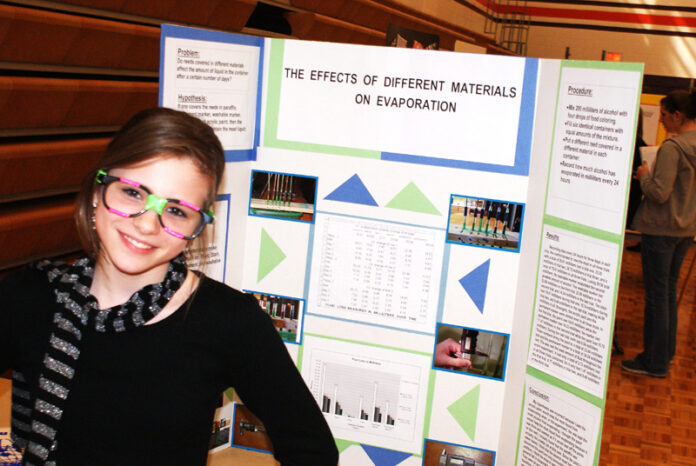
by Gene Marrano
The Roanoke County Science Fair for middle and high school students filled the William Byrd Middle School auditorium with dozens of science projects last Saturday. Judges selected a number of students that will move on to the Western Virginia Regional Science Fair at Hollins University on March 19. Two winners at that competition will receive paid trips to the International Science and Engineering Fair in Los Angeles (May 8-13). The first place winners at the regional fair also can receive a year’s worth of free tuition at Virginia Western Community College.
While there were plenty of more “mainstream” science projects on display there were also some more unusual ones – like “How do colors affect stink bugs?,” and the “decomposition of Sun Chips bags.” Savannah Stalnaker (William Byrd Middle called her entry “Popcorn,” which simply applied the taste test to several brands of popping corn. Stalnaker also counted the kernels from three different brands and measured how quickly they each popped. Her choice? “In my opinion Orville Redenbacher,” said Stalnaker.
Gwendylan Turner (William Byrd Middle) stood by her exhibit, “The Effects of Different Materials on Evaporation,” dressed in a stylish outfit for the big day. “I was curious about how you could color diffuser reeds, without affecting the amount of evaporation they would put off,” said the first time participant, using some sort of science-speak language. She called the exercise “pretty fun.” It took Turner nine days to put her entry together.
Michael Waering, who attends Northside High and the Roanoke Valley Governor’s School, entitled his project “Effect of solutions in water on the index of refraction,” which was inspired by something he learned in science class. “It measures how fast light goes through a substance,” said Waering, who used something called Snell’s Law to measure that speed.
Studying to be an engineer or doctor may be in his future. Waering will go on to the regional competition, courtesy of winning a competition at the Governor’s School. “It will look good on the college application,” he noted.
Julian Barnes, in his third year as the science coordinator for Roanoke County, made his rounds at the fair, along with the judges that selected projects for advancement to the regional meet. Some of them, advanced students for the most part, worked for “months and months and months,” noted Barnes, who still teaches some classes when not at the central office. “We started laying the groundwork at our teacher’s meeting in August. From almost day one [teachers were] introducing the notion of this project.” Much of the work was done on the student’s own time.
As for some of the topics selected for projects, Barnes chuckled: “its just great minds. You just wonder where the kids are. It’s powerful stuff. The kids want to make an impact.” Barnes said as many as 40 Roanoke County students could be chosen for the regional competition at Hollins.
Barnes is heartened that students are still interested in science. “These kids are very involved. Its great science and its absolutely wonderful. It’s a good cross section [of students].”

